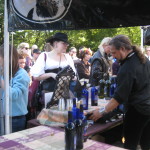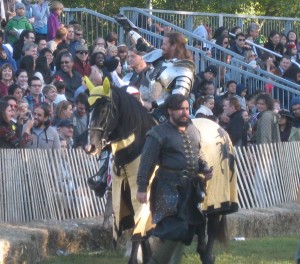You can only watch so many rounds of the Armed Combat League Championships before you start thirsting for a flagon of mead. At least, that was my experience at my first (yes, first!) medieval festival last weekend. This was a totally free one (yes, free!) staged annually at Fort Tryon Park surrounding the reconstructed-monastery-turned-museum, the Cloisters. I cannot express how awesome it is that the city parks department actually goes to great lengths to put on a massive celebration for teenaged enthusiasts of swordplay, accomplished players of the lute and harp, and people who enjoy dressing their dogs up as princesses.
 I did, however, think that the location in a public park would put a definite damper on my mead game. So imagine my surprise, when, after wending my way past armored contenders whacking each other with blunted axes, some slightly long-in-the-tooth Celtic dancers and a juggling performance by Joey the Jester, I came upon a special cordoned-off drinking area, where you could buy a ten-dollar beer or a glass of mead for eight. I think you already know, dear reader, which booth had the longer line.
I did, however, think that the location in a public park would put a definite damper on my mead game. So imagine my surprise, when, after wending my way past armored contenders whacking each other with blunted axes, some slightly long-in-the-tooth Celtic dancers and a juggling performance by Joey the Jester, I came upon a special cordoned-off drinking area, where you could buy a ten-dollar beer or a glass of mead for eight. I think you already know, dear reader, which booth had the longer line.
If you’re a stickler for historical accuracy, this might well have been your favorite part of the festival. A lot of the food could not really claim real medieval provenance (a lot of new-world foods like tomatoes popping up in sandwiches called The Merlin, for instance), but mead is actually much, much older. In fact, it was probably the original alcoholic drink, dating back something like at least 20,000 years, when rains would flood abandoned bee hives in Africa and the resulting honey-water mixture would ferment, allowing our ancestors to throw the first fraternity parties. In fact, honey, with its anti-microbial properties, was probably the reason that sugar-gobbling yeasts evolved in the first place, the same strains that would eventually allow us to ferment the first beer and wines. By the time of Beowolf, mead had established itself as the go-to drink for epic European heroes of all sorts.
Magpie Farms, the festival’s meadery, had strawberry and elderberry versions, but I went with the time-honored original. Mead tastes, as one might expect, like alcoholic honey—that is, very good and very sweet, sort of like a dessert wine. It is not exactly a drink that one guzzles, which led to quite a crowd milling about, gnawing on smoked turkey legs and admiring each others’ costumes. One guy had a flask built into the design of his armored belt, and believe me, it was much coveted.
Finally, I had to knock back the dregs of my glass so I could find a seat on the bleachers for the Grand Joust. Knights on horseback, some splintering lances, a pleasant haze brought on by the oldest alcohol known to man—you know, just your average afternoon in Manhattan.

